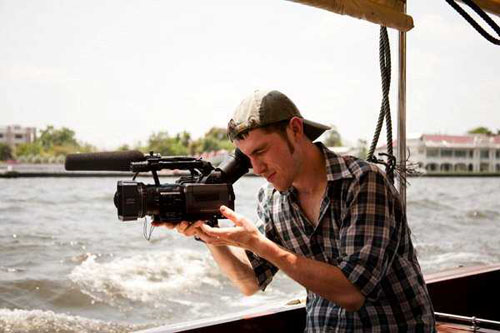 Back to selection
Back to selection
Five Questions with Cinema is Everywhere Director Teal Greyhavens

After a summer dominated by big budget Hollywood blockbusters, we could all use a film that reminds us of the humanity and joy of the medium. Teal Greyhavens’ Cinema is Everywhere follows actors and directors from four disparate cultures, creating an interwoven narrative fabric that lovingly renders the importance of film across the globe. Greyhavens’ documentary makes effort to explore cinema in countries where social and political barriers limit or restrict free speech; often, movies are the best opportunities people have to express their thoughts, fears and hopes. With such an ambitious scope the film could easily spread itself too thin, but the director tells each story with simplicity and grace, and succeeds in crafting a work that feels authentic in its universality.
Greyhavens, who filmed the documentary in 2009 while travelling on a Thomas J. Watson Fellowship, below talks about the literal and figurative journey of making Cinema is Everywhere.

Filmmaker: How did you decide to make this documentary? It seems like there are so many possible narrative threads for a film like this one — what drew you to the stories that feature in the movie?
Greyhavens: The key word for the project when it was in development was “explore.” It was an open-ended journey, without specific people to seek out and feature, more a framework into which I wanted to fit the stories I would come across…so the creative scope of the film really emerged from two things — the logistics of the year-long shoot, which was funded by the Thomas Watson Foundation, and pure serendipity. I set the itinerary to cover a wide range of countries and cultures, and then tried to include people from all strata of the cinema structure — established personalities mixed with unknown dreamers mixed with emerging talents — but beyond that much of the film came about through luck and aplomb.
Filmmaker: Tilda Swinton and Mark Cousins were the two most prominent film figures featured in the film. How did they get involved?
Greyhavens: Well, in a way the fact that many people have noticed Mark & Tilda foremost ties in to the inspiration for the film in the first place — because while of course Mark is a brilliant filmmaker and historian, and Tilda is one of the most fascinating actresses working today, in the documentary they are seen alongside personalities like Javed Akhtar and Stanley Kwan, who are equally revered within their own cultures (India and Hong Kong). Shyam Benegal, to name another, is a near legend in Hindi film, having pioneered the so-called Parallel cinema, following the great Satyajit Ray in Bengal. So I like to play up the global nature of the personalities involved, since the people you notice really depends on which country you’re coming from. But to answer your question, I got to know Mark while living in Edinburgh, as a kindred champion of international cinema, and as luck would have it the shooting of this film coincided with his and Tilda’s launch of the first Cinema of Dreams film festival…a project many of us are dearly hoping they revisit in years to come.
Filmmaker: What were the challenges of such a global production?
Greyhavens: The challenges were endless, and also a pleasure. I filmed probably about 25 hours of footage in which I had no idea what people were saying, due to language barriers and the fact that I couldn’t afford proper translators. In some countries I spent weeks trying to get official permission to film events and places, and in the end just went for the guerrilla approach, with mixed results. I was also aided by wonderful volunteer guides and assistants along the way, and I think the seat-of-the-pants nature of the production helped avoid the stiffer trappings of bigger budget productions and keep the film at ground level, which is where documentaries belong.
Filmmaker: This documentary allowed you to chronicle the stories of both established and up-and-coming filmmakers. How do you think that contrast informs the film?
Greyhavens: There is a notion espoused by some that filmmaking is a born talent, a thing that some have and others don’t. What I loved about spending time with both emerging filmmakers such as Karim Souaki in Tunisia and established greats like Tilda Swinton was noticing that at the end of the day, the dreams of both people are equally vivid, and what a cinema career cultivates is really the concrete skills, the connections, and the experience to make those dreams reality. The more films you work on, the more expertly you can bring your particular dreamworld to life. But the inner vitality, the essential spark of people who are passionate about cinema, is the same no matter who you are or what level your career is at.
Filmmaker: In regard to the fact that this was your first film, what specific difficulties did you face getting the picture made?
Greyhavens: I made this film the way so many young gusto-filled indie filmmakers do, which is, first make the film, then figure out what to do with it. Not surprisingly, the first part was wonderful. I got to travel, meet amazing people, and put together a hugely ambitious film. Then came the second part, wherein my producers and I faced the messy business of packaging and selling the film — the part filmmakers always want to pretend you don’t have to do because it’s art. So the film sat in limbo for the better part of a year while we pitched it to distributors and sales agents, before it got picked up for representation in 2011. Then more waiting ensued while we fine-tuned sound, score, and licensing. When we eventually opened at the Austin Film Festival almost two years had passed since shooting wrapped — a gap which never would have happened had I gone in with a concrete distribution plan. But it’s been a fantastic experience that has opened doors and sparked a global conversation on the role of cinema, which I hope will continue through our TUGG screening in L.A. on September 20th!

